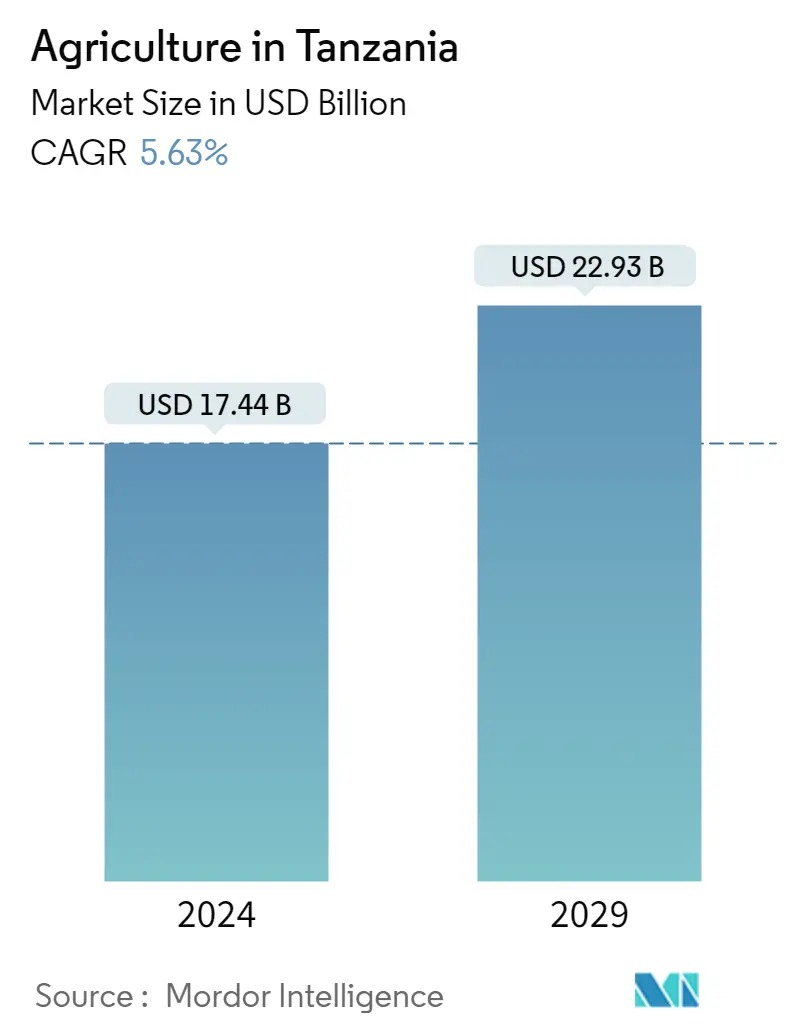Market Size of Agriculture in Tanzania

| Study Period | 2019 - 2029 |
| Base Year For Estimation | 2023 |
| Forecast Data Period | 2024 - 2029 |
| Market Size (2024) | USD 17.44 Billion |
| Market Size (2029) | USD 22.93 Billion |
| CAGR (2024 - 2029) | 5.63 % |
Major Players*Disclaimer: Major Players sorted in no particular order |
Tanzania Agriculture Market Analysis
The Agriculture in Tanzania Market size is estimated at USD 17.44 billion in 2024, and is expected to reach USD 22.93 billion by 2029, growing at a CAGR of 5.63% during the forecast period (2024-2029).
- Agriculture is the major backbone of the country's economy. Hence, structural measures are taken to boost agricultural production in the country with the support of public-private partnerships. Fruits hold a major share due to liberalization policies supporting their exports. Bananas, mangoes, oranges, pineapples, and watermelons are the major fruits produced in the country. Thus, private sector investments, favorable government policies, and trade agreements with neighboring countries will likely drive the market during the forecast period.
- Private sector investment in the agriculture sector, research activities conducted in collaboration with local institutions, and policy initiatives undertaken by the Tanzanian government to improve the business-enabling environment to promote agricultural growth will aid Tanzania's agricultural market development in the future.
- Tanzania is one of the largest cashew producers in Africa, with exports providing 10.0-15.0% of the country's foreign exchange. It mainly grows in the country's southern regions, such as Matwara and Lindi, and more than 90.0% of the nuts are exported in raw form. The raw nuts are mainly exported to India due to a very small domestic processing capacity. This factor is driving the agriculture market in the country.
Tanzania Agriculture Industry Segmentation
Tanzania's agriculture sector accounts for nearly one-third of the country's GDP and employs 75% of the workforce-has the potential to raise incomes and improve livelihoods.
The Tanzania agriculture market is segmented by crop type (food crops/cereals, fruits, and vegetables). The report provides insight into production analysis (volume), consumption analysis (value and volume), export analysis (value and volume), import analysis (value and volume), and price trend analysis.
The report offers market estimation and forecast in value (USD million) and volume (metric ton) for the above-mentioned segments.
| Crop Type(Production Analysis by Volume, Consumption Analysis by Volume and Value, Import Analysis by Volume and Value, Export Analysis by Volume and Value, and Price Trend Analysis) | |
| Food Crops/Cereals | |
| Fruits | |
| Vegetables |
Agriculture in Tanzania Size Summary
The agriculture sector in Tanzania is a pivotal component of the nation's economy, supported by a diverse range of production activities including livestock, staple food crops, and cash crops. The sector is poised for growth, driven by structural measures and public-private partnerships aimed at enhancing agricultural output. The government's favorable policies, coupled with private sector investments and trade agreements, are expected to propel the market forward. The fruit sector, particularly bananas, mangoes, oranges, pineapples, and watermelons, plays a significant role in the market, benefiting from liberalization policies that bolster exports. Tanzania's position as a leading cashew producer in Africa further underscores the sector's importance, with a substantial portion of the nuts exported, primarily to India, due to limited domestic processing capabilities.
The Tanzanian government's initiatives, such as the Southern Agricultural Growth Corridor (SAGCOT), aim to unlock the region's agricultural potential by fostering private sector engagement and attracting international funding. These efforts are complemented by research collaborations with local institutions to build capacity for sustainable agricultural development. The government's provision of subsidies and reduction of levies are strategic moves to address challenges and stimulate growth in the sector. The banana market, in particular, is thriving due to high consumer demand and efforts to develop new, resilient varieties. Recent policy shifts, such as the decision to explore genetically engineered crop trials, reflect a broader commitment to enhancing agricultural productivity and food security in the country.
Agriculture in Tanzania Market Size - Table of Contents
-
1. MARKET DYNAMICS
-
1.1 Market Overview
-
1.2 Market Drivers
-
1.3 Market Restraints
-
-
2. MARKET SEGMENTATION
-
2.1 Crop Type(Production Analysis by Volume, Consumption Analysis by Volume and Value, Import Analysis by Volume and Value, Export Analysis by Volume and Value, and Price Trend Analysis)
-
2.1.1 Food Crops/Cereals
-
2.1.2 Fruits
-
2.1.3 Vegetables
-
-
Agriculture in Tanzania Market Size FAQs
How big is the Agriculture in Tanzania Market?
The Agriculture in Tanzania Market size is expected to reach USD 17.44 billion in 2024 and grow at a CAGR of 5.63% to reach USD 22.93 billion by 2029.
What is the current Agriculture in Tanzania Market size?
In 2024, the Agriculture in Tanzania Market size is expected to reach USD 17.44 billion.

